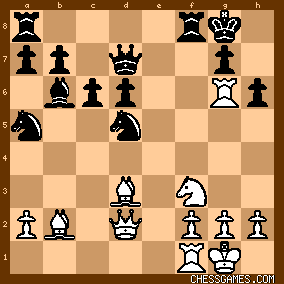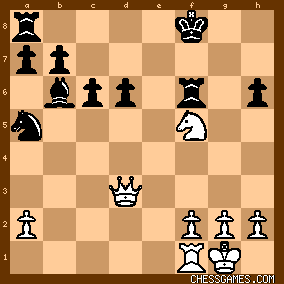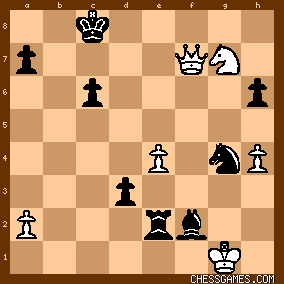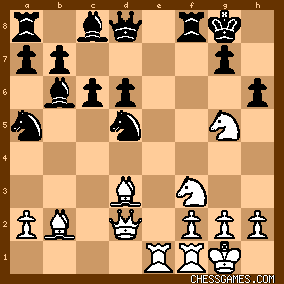| Mar-10-06 | | Knight13: 19... Rf7 20. Qxh8(The best, I think) and Black could survive longer, 19... Nf4 gives up the game, 19... Nf6 Qxh6 is crushing, Black is lost. |
|
| Jan-30-12 | | Knight13: The position after move 14 looks promising for White's obvious planned attack on the castled king. But then the attack gets liquidated by Black like it's nothing. There's got to be something there that White's missing! |
|
Jan-08-14
 | | offramp: With 19.Rg6 white puts a lot of pressure on g7.

click for larger view
White wins a queen for ♖♗♙. We reach a sort of an ending - although it is not really an ending; after 24...Kf8:

click for larger viewBut white's play becomes uncertain; and Steinitz improves his position.
After 36...Re4 things are looking very serious for white:

click for larger view37...d3, giving up a rook, spreads alarm throughout the white camp! Black plays 39...Bxf2+

click for larger view
...and white goes to the wrong square! Easy to do. His king gets the runaround and ♔ & ♕ get forked. |
|
| Jan-08-14 | | john barleycorn: It is hard to win a won game. How much harder is it to lose a won game? I guess you have to decline a draw first. |
|
| Jan-16-14 | | dernier thylacine: The circumstances of playing may explain partially the mistakes of Anderssen in this game; after a bad start in the match, he overwhelmed here in a spendid way his opponent but the end of his professional vacation became close while Steinitz could devote all his time to chess; so the german master tried to force matters: very dangerous attitude against such an opponent, even if Steinitz was still somewhat inferior to Anderssen at least until the tournament of Vienna 1873... After 36.Kf3! Steinitz was lost, and even after 37.Rc1! Anderssen could still win. Finally, he could obtain a drawn by perpetual after 40.Kg2! instead of the nervous 40.Kf1??, the last and this time mortal blunder. |
|
| Feb-24-18 | | Big Pawn: Anderssen missed 31.Qc8+ winning.
31.Qc8+ Bd8
Or else black loses immediately. Now with pressure off of f2, white can move his rook freely. 32.Rb1 Nb6
33.Qa6
Forking the rook and a7 pawn. After winning a7, blacks queenside is no longer fortress-like and whites rook can come crashing down the b file. |
|
| Feb-24-18 | | morfishine: <Big Pawn> Wow, how in the world could Anderssen miss that? Very strange. Your follow up is rock-solid, convincing ***** |
|
Mar-29-20
 | | dernier loup de T: So, Anderssen lost at least three opportunities to win this very well begun game: 31.Qc8+, as indicated by <Big Pawn>, 36.Kf3, and 37.Rc1; and finally, "cherry on the cake", the possibility to draw by 40.Kg2.
In the book of Gottschall which the games of Anderssen are published with annotations, (unfortunately VERY small characters in the new editions), all that is emphasized...
What a pity! |
|
Mar-29-20
 | | dernier loup de T: A elle seule, mais surtout compte tenu du score final du match qui en a résulté, cette partie montre que Steinitz n'était pas ENCORE supérieur à Anderssen
en 1866, ce que confirmera le tournoi de Baden Baden de 1870; c'est en 1873 seulement que Steinitz, grâce à un jeu positionner affiné, deviendra véritablement le plus fort joueur du monde comme on le voit en rejouant les parties du tournoi de Vienne disputé cette année-là, et celles de son match contre Blackburne trois ans plus tard. |
|
Mar-29-20
 | | dernier loup de T: Lire "positionnel", dans le com précédent. |
|
Nov-26-20
 | | nizmo11: <dernier loup de T>So, Anderssen lost at least three opportunities to win this very well begun game. The first chance was here:

click for larger view
17. Bh7+ Kh8 18.Nf7+! Rxf7 19.Qxh6 Nxf6 20.Qh4
This nice variation is Stockfish's first choice but according Harding's <Steinitz in London> was "discovered in the twentieth century by Russian analyst Victor Fridman." |
|
May-29-24
 | | kingscrusher: There are lots of different ideas here for what could give more solid results for the concept of "attack" in general, including: 1) Better calculation skills
2) Better ways of handling dangerous gambits - Ba5 not Bc5
3) Better calculation skills
4) Better calculation skills
Did I mention - "better calculation skills" - this seems in this particular opening example to be more important than "accumulating advantages first" With games of enormous complexity like this, gambits are made or broken on calculation and tactical skills. I guess one could turn to more positional openings to reduce the pressure on calculation skills though which is what happened in 1873 Vienna tournament in many games. |
|





